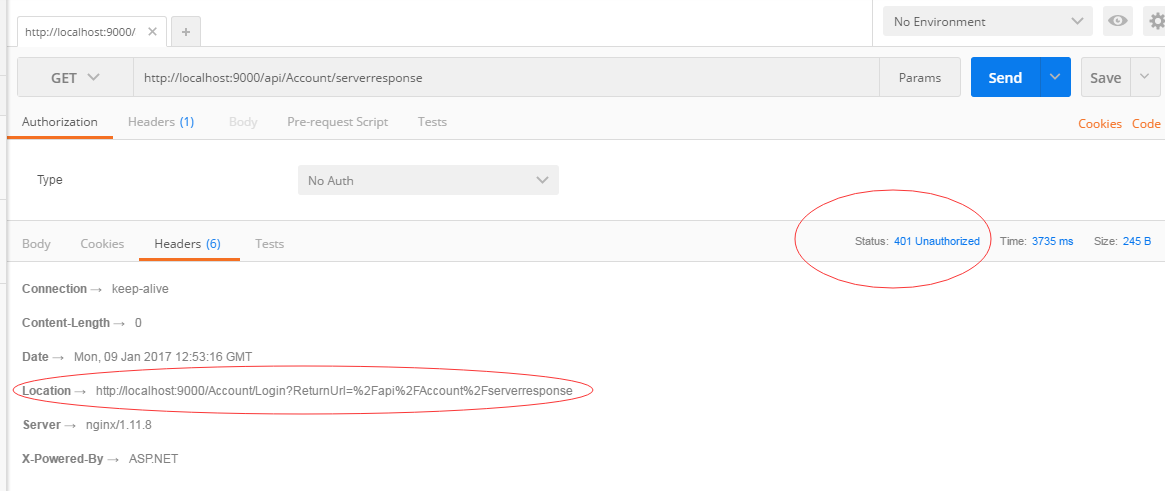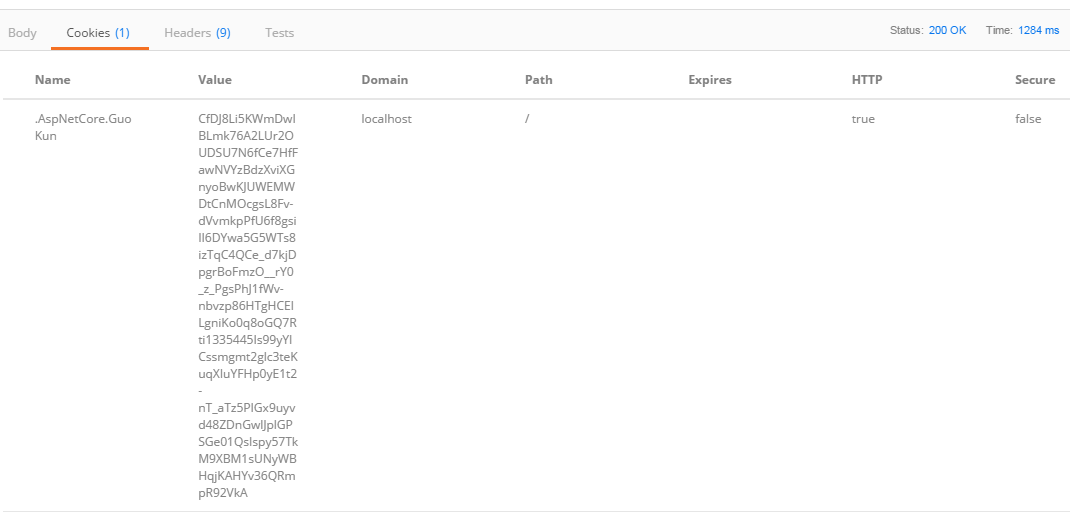asp.net core 认证及简单集群
众所周知,在Asp.net WebAPI中,认证是通过AuthenticationFilter过滤器实现的,我们通常的做法是自定义AuthenticationFilter,实现认证逻辑,认证通过,继续管道处理,认证失败,直接返回认证失败结果,类似如下:
public async Task AuthenticateAsync(HttpAuthenticationContext context, CancellationToken cancellationToken) { var principal = await this.AuthenticateAsync(context.Request); if (principal == null) { context.Request.Headers.GetCookies().Clear(); context.ErrorResult = new AuthenticationFailureResult("未授权请求", context.Request); } else { context.Principal = principal; } }
但在.net core中,AuthenticationFilter已经不复存在,取而代之的是认证中间件。至于理由,我想应该是微软觉得Authentication并非业务紧密相关的,放在管道中间件中更合适。那么,话说回来,在.net core中,我们应该怎么实现认证呢?如大家所愿,微软已经为我们提供了认证中间件。这里以CookieAuthenticationMiddleware中间件为例,来介绍认证的实现。
1、引用Microsoft.AspNetCore.Authentication.Cookies包。项目实践中引用的是"Microsoft.AspNetCore.Authentication.Cookies": "1.1.0"。
2、Startup中注册及配置认证、授权服务:
服务注册:
services.AddMvc(options => { //添加模型绑定过滤器 options.Filters.Add(typeof(ModelValidateActionFilter)); //添加授权过滤器,以便强制执行Authentication跳转及屏蔽逻辑 //var policy = new AuthorizationPolicyBuilder().RequireAuthenticatedUser().Build(); var policy = new AuthorizationPolicyBuilder().AddRequirements(new AuthenticationRequirement()).Build(); options.Filters.Add(new AuthorizeFilter(policy)); }); //services.AddAuthorization(options => //{ // options.AddPolicy("RequireAuthentication", policy => policy.AddRequirements(new AuthenticationRequirement())); //});
大家注意,上面代码中有两处注释掉的地方。第一处注释,RequireAuthenticatedUser()是.net core预定义的授权验证,代表通过授权验证的最低要求是提供经过认证的Identity。Demo中,我的要求也是这个,只要是经过基本认证的用户即可,那为什么Demo中没有使用呢?因为这里是个坑!实际实践中,我发现,采用注释中的做法,无论如何,调用总是返回401,迫不得已,download认证及授权源码,发现该处逻辑是这样的:
var user = context.User; var userIsAnonymous = user?.Identity == null || !user.Identities.Any(i => i.IsAuthenticated); if (!userIsAnonymous) { context.Succeed(requirement); }
加入断点猛调,发现IsAuthenticated永远是false!!!迫不得已,反编译查看源码,发现ClaimsIdentity的IsAuthenticated属性是这样定义的:

WTF!!!坑爹么这是!!!.net framework中, 记得 这里的逻辑是,只要Name非空,就返回true,到了.net core中成了这样,你说坑不坑。。。
那怎么办?总不能放弃吧?我想,大家第一想法应该是继承ClaimsIdentity自定义一个Identity,尤其是看到属性上那个virtual的时候,我也不例外。可继承后, 发现认证框架那儿依然不认,还是一直返回false,可能是我哪里用的不对吧。所以,Startup中第一处注释出现了。最终解决方案是自定义AuthenticationRequirement及处理器,实现要求的验证,如下:
public class AuthenticationRequirement : AuthorizationHandler<AuthenticationRequirement>, IAuthorizationRequirement { protected override Task HandleRequirementAsync(AuthorizationHandlerContext context, AuthenticationRequirement requirement) { var user = context.User; var userIsAnonymous = user?.Identity == null || string.IsNullOrWhiteSpace(user.Identity.Name); if (!userIsAnonymous) { context.Succeed(requirement); } return TaskCache.CompletedTask; } }
上述代码红色的部分便是相对默认实现变化的部分。
startup中第二部分注释,是注册授权策略的,注册方法也是官网文档中给出的注册方法。那为什么这里又没有采用呢?因为,如果按注释中的方法配置,我需要在每个希望认证的控制器或方法上都用Authorize标记,甚至还需要在特性上配置角色或策略,而这里我的预设是全局认证,所以,直接以全局过滤器的形式添加到了MVC处理管道中。读到这里,细心的读者应该有疑问了,你一个简单的认证,跟授权毛线关系啊,注册授权过滤器作甚!我也觉得没关系啊,这是net core认证的第二个坑,那就是,在.net core或者微软看来,认证仅仅提供Principal的生成、序列化、反序列化及重新生成Principal,它的职责确实也包括了返回401、403等各种认证失败信息,但这部分不会主动触发,必须有处理管道中其他逻辑去触发。我仔细阅读了官网文档,得出的大致结论是,.net core大概认为,认证是个多样化的过程,不光有我们目前看到的或需要的某一种认证,实际需求中很可能会多种认证并存,我们的API也可能会同时允许多种认证方式通过,所以某一种认证失败就直接返回401或403是错误的。这是实践当中第二个坑!那话说回来,添加了授权,就可以触发这个过程,这个是看源码发现的,具体流程就是,如果授权失败,过滤器会返回一个challengeResult,这个Result最终会跑到认证中间件中的对应Challenge方法,在.net core源码中表现如下:
public async Task ChallengeAsync(ChallengeContext context) { ChallengeCalled = true; var handled = false; if (ShouldHandleScheme(context.AuthenticationScheme, Options.AutomaticChallenge)) { switch (context.Behavior) { case ChallengeBehavior.Automatic: // If there is a principal already, invoke the forbidden code path var result = await HandleAuthenticateOnceSafeAsync(); if (result?.Ticket?.Principal != null) { goto case ChallengeBehavior.Forbidden; } goto case ChallengeBehavior.Unauthorized; case ChallengeBehavior.Unauthorized: handled = await HandleUnauthorizedAsync(context); Logger.AuthenticationSchemeChallenged(Options.AuthenticationScheme); break; case ChallengeBehavior.Forbidden: handled = await HandleForbiddenAsync(context); Logger.AuthenticationSchemeForbidden(Options.AuthenticationScheme); break; } context.Accept(); } if (!handled && PriorHandler != null) { await PriorHandler.ChallengeAsync(context); } }
以其中HandleForbiddenAsync为例,具体又如下:
/// <summary> /// Override this method to deal with a challenge that is forbidden. /// </summary> /// <param name="context"></param> protected virtual Task<bool> HandleForbiddenAsync(ChallengeContext context) { Response.StatusCode = 403; return Task.FromResult(true); }
这样,经由授权流程触发Challenge,Challenge返回相应验证结果到API调用方。
注册完了认证及授权所需相关服务,接下来注册中间件,如下:
app.UseCookieAuthentication(new CookieAuthenticationOptions { AuthenticationScheme = "GuoKun", AutomaticAuthenticate = true, AutomaticChallenge = true, DataProtectionProvider = DataProtectionProvider.Create(new DirectoryInfo(env.ContentRootPath)) });
app.UseMvc();
注意UseCookieAuthentication要放在UseMvc前面。大家注意其中红色部分,这里为什么要自己手动创建DataProtectionProvider呢?因为这里是要做服务集群的,如果单机或单服务实例情况下,采用默认DataProtection机制就可以了。代码中手动指定目录创建,与默认实现的区别就是,默认实现会生成一个与当前机器及应用相关的key进行数据加解密,而手动指定目录创建provider,会在指定的目录下生成一个key的xml文件。这样,服务集群部署时候,加解密key一样,加解密得到的报文也是一致的。别问我怎么知道的,踩过坑,使劲儿调试,外加看官网文档,泪流满面。。。
3、添加控制器模拟登陆及认证授权
[Route("api/[controller]")] public class AccountController : Controller { [AllowAnonymous] [HttpPost("login")] public async Task Login([FromBody]User user) { IEnumerable<Claim> claims = new List<Claim>() { new Claim(ClaimTypes.Name, user.UID) }; await HttpContext.Authentication.SignInAsync("GuoKun", new ClaimsPrincipal(new ClaimsIdentity(claims))); } [HttpGet("serverresponse")] public ContentResult ServerResponse() { return this.Content($"来自{((Microsoft.AspNetCore.Server.Kestrel.Internal.Http.ConnectionContext)this.HttpContext.Features).LocalEndPoint.ToString()}的响应:{this.User.Identity.Name ?? "匿名"},您好"); } }
因为授权现在是全局的,所以在登陆方法上用AllowAnonymous标记,跳过认证及授权。
在ServerResponse方法中,返回当前服务实例绑定的IP及端口号。由于本Demo是采用ANCM寄宿在IIS中的,所以具体服务实例绑定的端口是动态的。
4、部署。具体在IIS中的部署如下:

三个站点的端口分别为9001,9002,9003,具体运行时,ANCM会将IIS的请求代理到KestrlServer。
5、Nginx负载均衡配置:
upstream guokun { server localhost:9001; server localhost:9002; server localhost:9003; } server { listen 9000; server_name localhost; #charset koi8-r; #access_log logs/host.access.log main; location / { root html; index index.html index.htm; proxy_pass http://guokun; }
这个比较简单,不废话。
6、运行效果:
这里采用Postman模拟请求。当未调用登录API,直接请求api/Account/serverresponse时,如下:

可以看到,直接401了,而且,响应标头中,有个Location,这个是challenge中默认实现的,告诉我们需要去登录认证,认证完了会跳转到当前请求资源url(在MVC中尤其有用)。
接下来,登录:


我们可以看到,登录成功,而且,服务端返回了加密及序列化后的凭证。接下来,我们再请求api/Account/serverresponse:

看到没,请求成功。那么多请求几次,分别得到如下结果:


可以看见,请求已经被负载到了不同的服务实例。
有人会问,为什么不部署在多台不同服务器上啊,搞一台机器在那儿模拟。哥没那么多钱整那么多台机器啊,而且,装虚拟机,配置撑不了,望大神勿喷勿吐槽。
如此,一个简易的基于asp.net core,带认证,具有集群负载的后端,便实现了。
补充说明:
之前,由于网络原因,ClaimsIdentity部分没有下载源码,而是直接反编译的方式查看,导致得出ClaimsIdentity.IsAuthenticated总是返回false的结论,在此更正,并特别感谢Savorboard大神的特别指正。经过翻阅Github上源码,该属性是这样定义的:
/// <summary> /// Gets a value that indicates if the user has been authenticated. /// </summary> public virtual bool IsAuthenticated { get { return !string.IsNullOrEmpty(_authenticationType); } }
之前一直返回false,则是由于登录成功构建ClaimsIdentity时没有指定AuthenticationType。弄清楚了这个,那么对应授权策略的注册,就可以采用如下方式了:
services.AddMvc(options => { //添加模型绑定过滤器 options.Filters.Add(typeof(ModelValidateActionFilter)); //添加授权过滤器,以便强制执行Authentication跳转及屏蔽逻辑 var policy = new AuthorizationPolicyBuilder().RequireAuthenticatedUser().Build(); //var policy = new AuthorizationPolicyBuilder().AddRequirements(new AuthenticationRequirement()).Build(); options.Filters.Add(new AuthorizeFilter(policy)); });
相应地,在登录成功后,构建ClaimsIdentity时指定其AuthenticationType:
await HttpContext.Authentication.SignInAsync("GuoKun", new ClaimsPrincipal(new ClaimsIdentity(claims, "GuoKun")));



